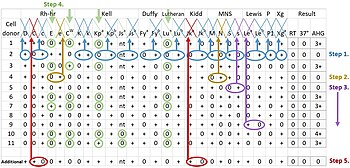MNS antigen system
The MNS antigen system is a
but the five most important are called M, N, S, s, and U.The system can be thought of as two separate groups: the M and N
The MN blood group
The MN blood group in humans is under the control of a pair of
The MN blood group system is under the control of an
M+ and N+ RBCs are common (75% of population) and M+N+ cells are the most common genotype (50% of population). These antigens were an early discovery and are some of the oldest blood antigens known after the
Anti-N is sometimes seen in dialysis patients due to cross-reactions with the residual formaldehyde from sterilizing the equipment. This is usually irrelevant for transfusion since this variant of the antibody does not react at body temperature.[citation needed]
The U and Ss groups: an overview
The S antigen is relatively common (~55% of the population) and the s antigen is very common (~89% of the population). Anti-S and anti-s can cause
Other MNS antigens
The other 41 identified antigens in the MNS group are low incidence, such as He (0.8% of the population) or high incidence, such as ENa (>99.9% of the population).
MNS glycoproteins and genes
Antigens of the MNS system are located on one of two glycoproteins: glycophorin A (GPA, CD235A) and glycophorin B (GPB, CD235B).[6] Each glycoprotein crosses the membrane once and has an external N-terminal domain (varying in length from 44 amino acids for GPB to 72 amino acids in length for GPA)[6] as well as a C-terminal cytosolic domain (GPB, 8 amino acids in length; GPA, 36 amino acids in length).[6]
MNS antibodies

- MNS antibodies display dosage (they react stronger against cells which are homozygous vs heterozygous for the antigen in question).
- Anti-M and anti-N antibodies are naturally occurring, cold-reacting IgM-class antibodies.[7]
- Anti-M and anti-N are generally clinically insignificant.
- Anti-S, anti-s and anti-U antibodies are acquired following exposure (via pregnancy or past transfusion with blood products) and are warm-reacting IgG-class antibodies.[7]
- Anti-S, anti-s and anti-U are usually clinically significant.
References
- https://www.mun.ca/biology/scarr/MN_bloodgroup.html
- Mark E. Brecher, Editor (2005), AABB Technical Manual, 15th edition, Bethesda, MD: AABB, ISBN 1-56395-196-7, p. 336-340
- Denise M. Harmening (1999), Modern Blood Banking and Transfusion Practices, Philadelphia, PA: F.A. Davis Company, p. 164-169
- ^ Daniels G, Flegel WA, Fletcher A, et al. International Society of Blood Transfusion Committee on Terminology for Red Cell Surface Antigens: Cape Town Report. Vox Sang 2007; 92: 250-3.
- ^ Poole J, Daniels G. Blood Group Antibodies and Their Significance in Transfusion Medicine. Transfus Med Rev 2007; 21: 58-71.
- ^ Daniels G. Human Blood Groups. 2nd Ed. Oxford: Blackwell Science, 2002.
- ^ ISBT Committee on Terminology for Red Cell Surface Antigens. "Table of blood group antigens within systems". International Society for Blood Transfusion. Archived from the original on 2011-08-18. Retrieved 2010-01-24.
- ^ Ralph H. Kathan and Anthony Adamany. 1967. Comparison of Human MM, NN, and MN Blood Group Antigens. The Journal of Biological Chemistry, 242, 1736-1722.
- ^ a b c Roback JD et al. AABB Technical Manual, 16th Ed. Bethesda: AABB Press, 2008.
- ^ a b Mais DD. ASCP Quick Compendium of Clinical Pathology, 2nd Ed. Chicago: ASCP Press, 2009.
External links
- MNS system at NIH
